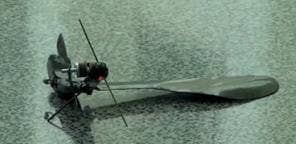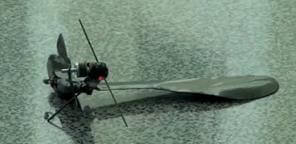Amazing Monocopter Flies With Just One Wing (Video)

Share
The University of Maryland has produced a flying machine with only one wing - a monocopter! Evan Ulrich, its PhD student creator, modeled the micro air vehicle (MAV) on a maple seed samara. Using a propeller, the Samara MAV spins itself in a circle around the end of the wing, creating lift that causes it to fly. Small changes to the pitch of the wing allow Ulrich to control where it goes. Trust me, you've never seen anything like this before - check it out in the videos below.
The US military spends hundreds of millions on drones and drone-supported operations. Ulrich's Samara MAV is funded in part by DARPA's Nano-air Vehicle initiative which is aimed at expanding the diversity and applications of those drones. While we've seen various rotor-based unmanned aerial vehicles (UAVs) in the past, but this monocopter is unique. It makes a complete rotation several times per second, allowing an onboard camera to collect a full 360 panoramic view. With the right video software, the Samara MAV could provide extremely detailed and virtual 3D images of its environment. With its small size, thousands could be deployed in an area at relatively low cost.
The following video gives an awesome history of how the Samara MAV, feel free to rock out.
In this second clip Ulrich discusses a few of the advantages of the MAV and its possible applications.
Be Part of the Future
Sign up to receive top stories about groundbreaking technologies and visionary thinkers from SingularityHub.


At the end of the second video, we see the view from an on board camera. Clearly that image would need to be processed (perhaps even taken with a different kind of a camera) in order to provide the panoramic observations I discussed above. Considering how quickly video technology advances however, I'm sure that the means to collect data from the MAV could be constructed rather soon, it if doesn't exist already.
The Samara is such a unique flying vehicle that the way it works can seem confusing. A propeller and weight sit on either end of a beam which is attached to the end of the single wing. That beam isn't an airfoil. Instead, it just provides the structural support to get the wing rotating. It's the wing which provides all the lift. Variations in wing pitch (controlled by a motor) and changes in propeller force can each cause the monocopter to move up and down. An autopilot system already allows the Samara MAV to maintain its own vertical position. Horizontal movement is controlled by precisely timed variations in wing orientation and speed at desired points along the MAV's rotation. There' s a patent pending, and more information on the Samara's flight can be found in this paper presented to the American Helicopter Society.
At first glance, the monocopter may seem like little more than a novelty. It's small, only nine grams with no dimension longer than 15 cm, and it can only sustain about 10 minutes of flight. If it is fully developed, however, the Samara could become the model for easily deployable, perhaps even disposable, spy drones. Drop the MAV from on high and let it auto-rotate down like a maple seed, using its short battery life to steer it as needed, while it spins and collects full 360 degree views of a battlefield. Or make them out of decomposable materials and use them to survey huge fields of wilderness. Hook them up to the Internet of things and they become invaluable, all-seeing monitors. The possibilities are there, though it is likely to take a long time to bring them to fruition. That's alright, Ulrich's been working on this thing for almost four years, what's a few more?
[screen capture and video credits: Ulrich/University of Maryland as Robo Seed on YouTube]
[source: Project 9 Robotic Samara, Journal of the American Helicopter Society, AIAA Journal of Aircraft]
Related Articles

These Robots Are the Size of Single Cells and Cost Just a Penny Apiece

In Wild Experiment, Surgeon Uses Robot to Remove Blood Clot in Brain 4,000 Miles Away

A Squishy New Robotic ‘Eye’ Automatically Focuses Like Our Own
What we’re reading
